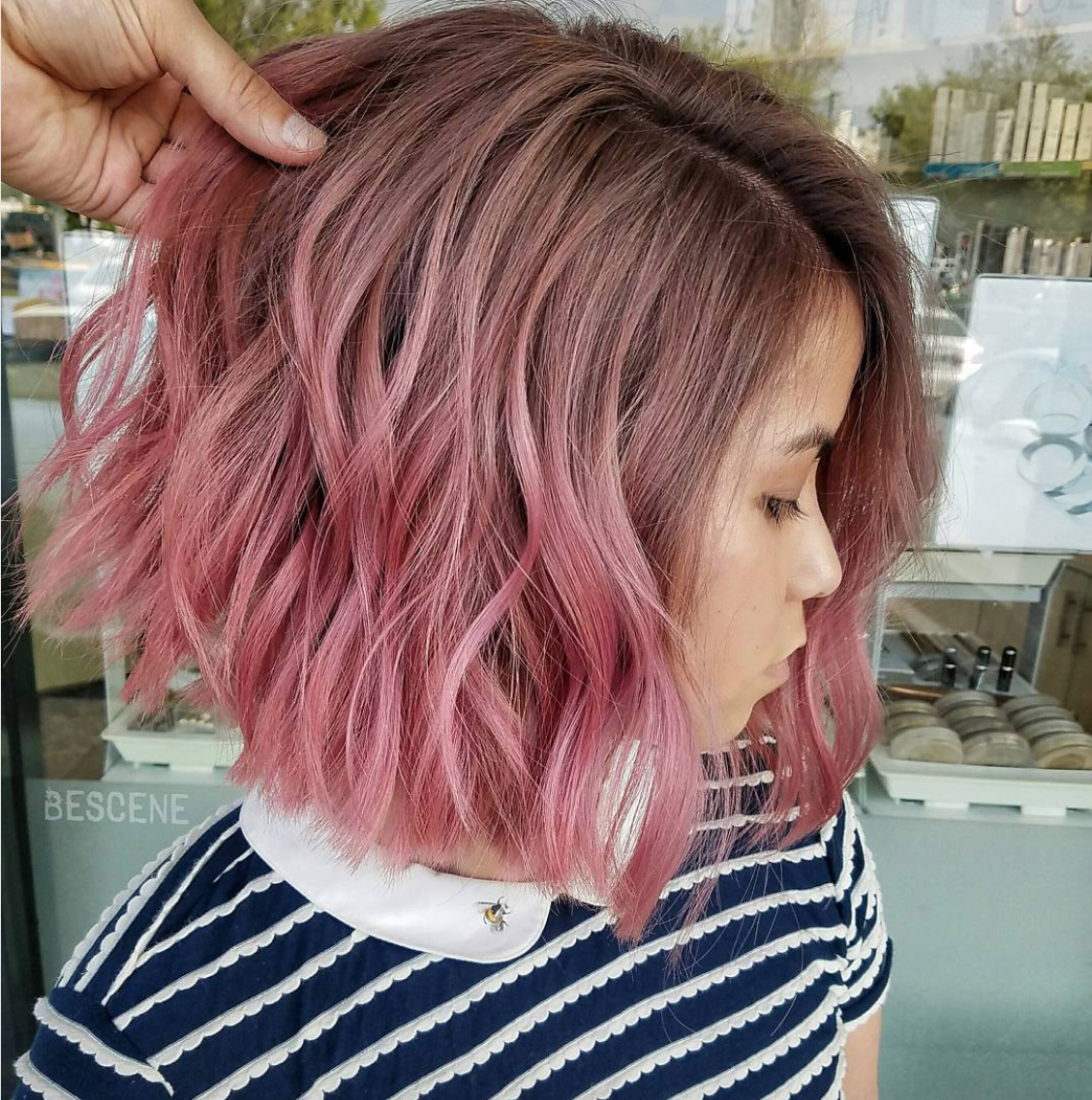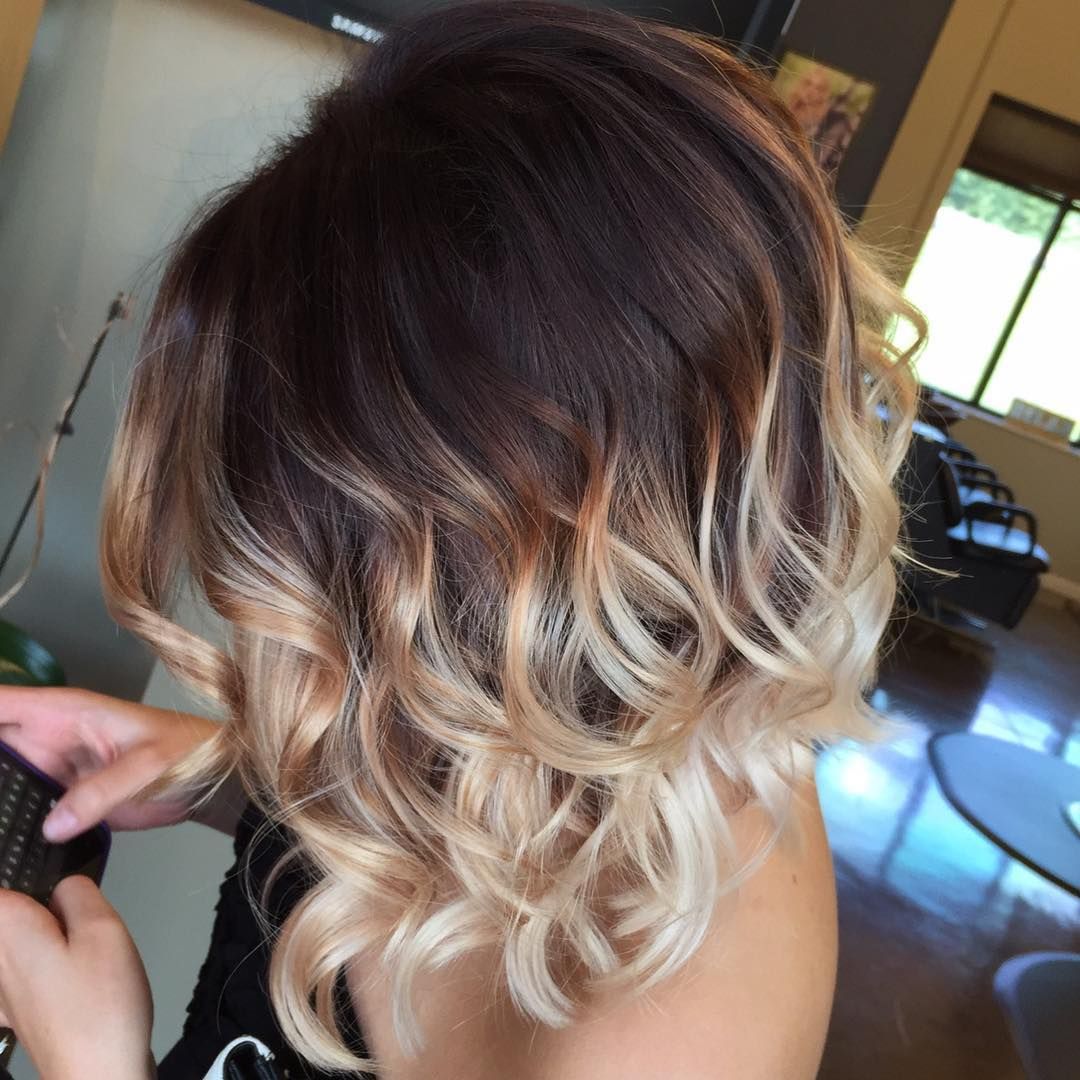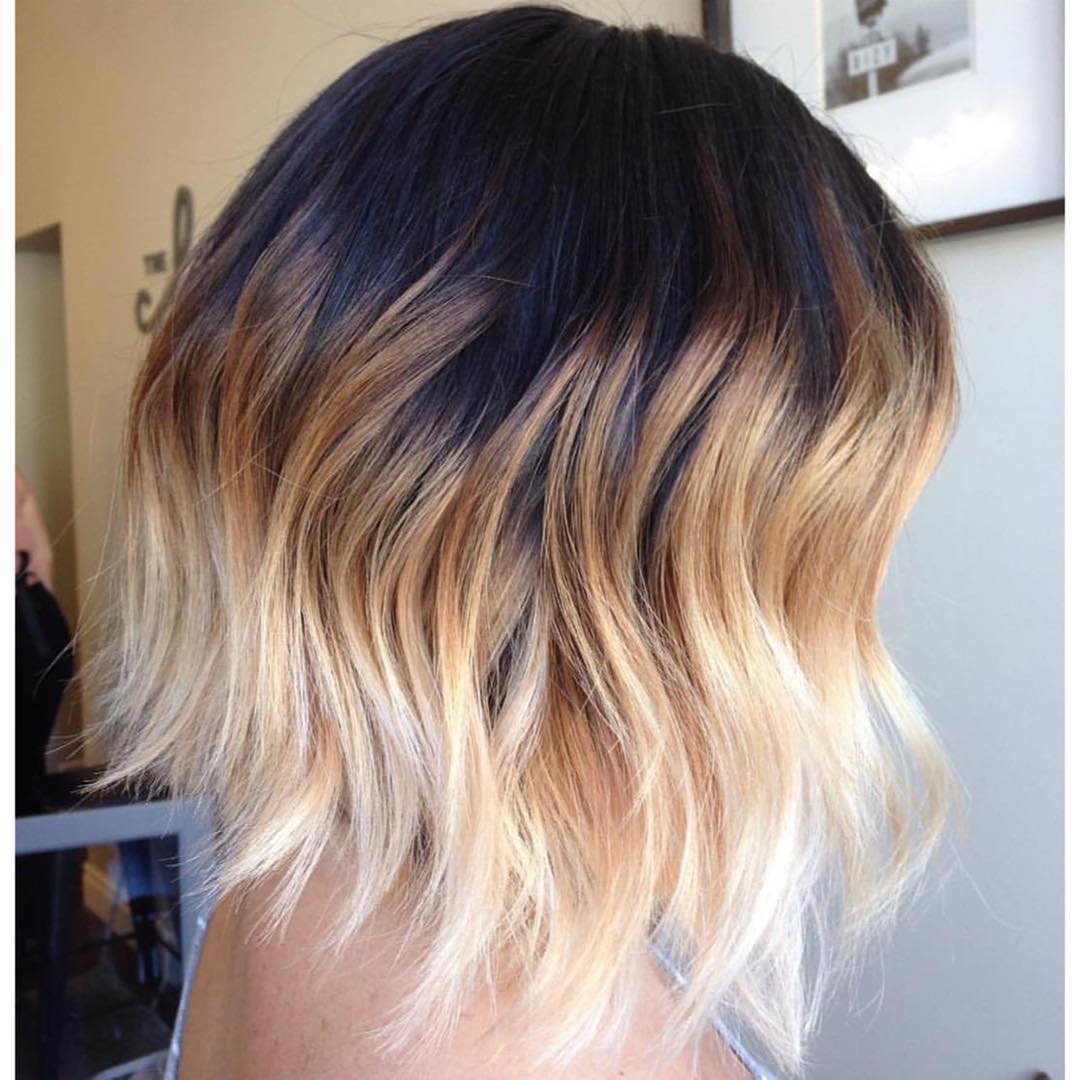Ombre Color On Short Hair - Your Guide To Shaded Styles
Have you ever thought about giving your short hair a fresh, new appearance? Maybe you're considering a style that brings a bit of light and dimension without needing a full color change. For many, a shaded look, often called ombre, might be just the thing. It’s a way to add some depth and brightness to your shorter strands, creating a really pleasing visual effect. This particular style has, you know, gained a lot of admirers over time for its gentle, sun-kissed feel. It's almost as if your hair naturally picked up a lighter tone at the ends.
The word "ombre," as a matter of fact, comes from French, meaning "shaded." It describes a gentle merging of one color into another, typically moving from a darker shade at the top to a lighter one further down. This technique has certainly become a very popular choice for hair color, allowing for a soft transition that looks quite natural. It's about letting the lower parts of your hair show a brighter appearance compared to the upper sections.
This piece will walk you through what ombre is all about, especially when applied to shorter hair lengths. We’ll look at how it differs from other coloring methods, what steps are involved in getting this look, and how you can keep your new shaded style looking wonderful. You'll also find out how some well-known people, like Hillary Swank, have worn this kind of hair. So, let’s explore the possibilities for your short hair.
- Do Men Like Their Nipples Sucked
- Unicorn Makeup For Halloween
- Bob Haircuts
- Cara Delevingne Brown Hair
- Defined Lips
Table of Contents
- The Story Behind Ombre - A Shaded Look
- What Makes Ombre Color Different?
- Getting the Ombre Color on Short Hair - What's Involved?
- Is Ombre Color Right for Your Short Hair?
- Celebrity Inspiration - Hillary Swank and Ombre Hair
- Hillary Swank's Personal Details
- Keeping Your Ombre Color Fresh - Short Hair Care
- How Can You Maintain Your Ombre Color on Short Hair?
- The Appeal of Ombre Color on Short Hair
The Story Behind Ombre - A Shaded Look
The concept of ombre, which literally means "shaded" in French, describes a smooth, gradual shift from one color tone to another. Typically, this involves moving from darker shades to lighter ones. It's a method that has, you know, become quite a common and sought-after way to color hair. The idea comes from the French word "ombrer," which means "to shade," originating from the Italian "ombrare," and even further back from the Latin "umbra," meaning "shade." This connection to shadows really tells you what the style is all about.
In some respects, this coloring approach creates a look where the bottom part of your hair appears noticeably lighter than the top. To get this particular visual effect, it's often necessary to lighten the lower sections of the hair. This gradual shift, or gradient, can move from a darker tone to a lighter one, or, in some situations, from one distinct color to another. It’s a style that tends to make a statement, offering a striking yet gentle change in your hair's appearance.
Traditionally, ombre hair shows off darker tones near the roots, gradually becoming lighter towards the ends. This method involves the person applying the color keeping the hair darker from the roots down to the middle of the strands, then making it lighter from the middle down to the very tips. This particular style was, you know, quite a significant trend when it first came out, and it has continued to be a much-loved way to color hair for many people.
- Dirty Santa Exchange Gift Ideas
- Center Part Fringe
- Hot Towel Treatment
- Annie Andrews Congress
- Date Ideas Rainy Day
What Makes Ombre Color Different?
You might be wondering how ombre, a specific kind of shaded color, is different from other ways of adding lighter sections to hair, especially since both ombre and a technique called balayage involve a shift from darker to lighter tones. Bryant, a hair expert, explains that ombre was a distinct coloring method in itself. The main difference really comes down to how the color is applied and the final look it creates.
With ombre, the lower section of the hair is lightened, which gives a more defined line where the color transition happens, even if it's a soft one. It’s a more uniform lightening across the ends, creating a clear, two-toned effect. Balayage, on the other hand, is a painting technique where the color is swept onto the hair in a way that creates more natural, sun-kissed streaks, often higher up in the hair. So, while both offer a lighter appearance towards the ends, the way the ombre color sits on short hair tends to be more of a distinct block of lighter color at the bottom.
Think of it this way: ombre is a more obvious, yet still blended, transition from dark to light, like a distinct dip-dye effect but softer. Balayage is more like hand-painted highlights that look as if the sun naturally lightened strands here and there. For short hair, this means ombre can offer a bolder statement, with a clear line of lightness that frames your face or neck, whereas balayage might give a more subtle, scattered brightness.
Getting the Ombre Color on Short Hair - What's Involved?
Achieving the ombre color on short hair involves a few key steps to make sure the transition looks smooth and flattering. Since your hair is shorter, the area for the color blend is, you know, a bit more compact. This means the person applying the color needs to be quite skilled to create that gentle shift in a smaller space. They will typically keep the hair darker at the roots, moving down to the middle section, and then gradually lighten it from the mid-shaft to the very ends.
The process usually starts with selecting the right shades. For a classic ombre, you'd pick a darker color for the top portion of your hair and a lighter shade for the bottom. The contrast can be soft and subtle, or quite striking, depending on your preference. To get that lighter bottom section, a bleaching product is often used. This part of the process needs to be handled with care to protect your hair's health.
After the lightening, a toner might be applied to achieve the exact shade you want and to ensure the blend is just right. The goal is a seamless gradient that looks natural, even with a clear distinction between the two tones. This is particularly true for ombre color on short hair, where every bit of the blend is really visible.
Is Ombre Color Right for Your Short Hair?
Considering ombre color for short hair is a great idea for many reasons. It can add so much visual interest and dimension without requiring you to color your entire head. If you’re someone who likes a bit of a dramatic change but also wants something that grows out gracefully, this could be a good choice. The way the color shifts means you won't have a harsh line of regrowth at your roots, which is, you know, pretty convenient.
For those with bobs, pixies, or other shorter styles, ombre can truly highlight the shape of your haircut. The lighter ends draw attention to the lines and angles of your style, making it appear more structured and lively. It’s a way to give your short hair a pop of brightness, making it seem fuller and more textured.
However, it's worth thinking about the length of your hair when planning your ombre. On very short hair, the transition from dark to light will be quite quick, so the colorist needs to be very precise. On a bob, you have more length to play with for a longer, more flowing gradient. It really just depends on the exact look you are going for and the skill of the person doing your hair.
Celebrity Inspiration - Hillary Swank and Ombre Hair
Many famous people have worn ombre hair, showing just how versatile and appealing this style can be. One such person is the truly gifted actress Hillary Swank. She has shown us how beautifully you can wear this shaded look, especially with a soft and gentle approach. Her hair, you know, often appears with a subtle shift in color that frames her face wonderfully, proving that ombre can be understated yet still make a statement.
Hillary Swank's choice of a soft ombre style really shows how this technique can work for those who prefer a more natural appearance. It’s not about a stark contrast, but rather a gentle lightening that looks as if the sun naturally touched her ends. This kind of subtle ombre color on short hair can add a touch of warmth and glow to your overall look, without being too bold.
Her appearances often feature hair that has this kind of gradual brightening, which complements her features and adds depth to her hairstyles. It just goes to show that this technique is not just for long, flowing locks, but can be adapted to many lengths, including shorter ones, to create a refined and lovely finish.
Hillary Swank's Personal Details
For those interested in the accomplished actress who has showcased the subtle ombre style, here are some personal details about Hillary Swank.
| Detail | Information |
|---|---|
| Full Name | Hillary Ann Swank |
| Date of Birth | July 30, 1974 |
| Place of Birth | Lincoln, Nebraska, U.S. |
| Occupation | Actress, Producer |
| Notable Works | "Boys Don't Cry," "Million Dollar Baby" |
Keeping Your Ombre Color Fresh - Short Hair Care
Once you have your lovely ombre color on short hair, you'll want to make sure it stays looking its best. Taking good care of colored hair is always important, but with ombre, there are a few specific things to keep in mind. Since the lower sections of your hair have been lightened, they might be a bit more delicate and need some extra attention.
Using products specifically made for color-treated hair is a very good idea. These items are designed to help preserve your color and keep your hair healthy. Look for shampoos and conditioners that are sulfate-free, as sulfates can strip away color and moisture. Also, a good leave-in conditioner or a hair mask used once a week can help keep those lighter ends feeling soft and looking shiny.
Protecting your hair from heat is also quite important. If you use hot tools like flat irons or curling wands, always apply a heat protectant spray first. This will help prevent damage to your hair and keep your ombre color looking vibrant. Limiting how often you use heat styling can also make a big difference in the long run, too it's almost a given for healthy hair.
How Can You Maintain Your Ombre Color on Short Hair?
Maintaining your ombre color on short hair is generally pretty simple, which is one of the reasons many people choose this style. Since the roots are kept darker, you don't have to worry about a harsh line appearing as your hair grows out. This means fewer trips to the salon for touch-ups compared to a full head of highlights or a single all-over color.
However, you will want to keep an eye on the condition of your lighter ends. Over time, these sections might start to feel a bit dry or lose some of their brightness. Regular trims will help keep your short hair looking neat and remove any split ends, which is particularly helpful for maintaining the overall look of your ombre.
You might also consider using a toning shampoo or conditioner once in a while, especially if your lighter ends start to look a bit brassy. Purple shampoos, for example, can help counteract unwanted yellow or orange tones. This is a simple way to refresh your ombre color and keep it looking fresh between salon visits. In short, a little care goes a long way.
The Appeal of Ombre Color on Short Hair
The appeal of ombre color on short hair is quite strong for a number of reasons. For one, it offers a distinct visual effect that really makes your haircut stand out. The way the color gently shifts from dark to light creates a sense of movement and depth, even on shorter lengths. It's a look that feels modern and stylish, yet also has a timeless quality about it.
It’s also a relatively low-upkeep style, which is a big plus for many people. Since the darker part of the ombre is at your roots, you don't have to deal with obvious regrowth lines every few weeks. This means you can go longer between salon visits, saving both time and money. That is, you know, a pretty practical benefit.
Moreover, ombre allows for a lot of creative freedom. You can choose a subtle, natural-looking transition, or go for a bolder, more dramatic contrast. You can even experiment with different color combinations, like a natural brown fading into a vibrant blue or pink, though traditional ombre tends to stick to natural hair tones. The possibilities for expressing your personal style are, you know, quite vast with this technique. It’s a versatile choice that can really make your short hair feel special.
Article Recommendations
- Face Massage Before And After
- Summer Cute Hairstyles
- Best Shows From The 2000s
- Pubic Area Exfoliant
- How Often Do Girls Get Horny



Detail Author:
- Name : Kaci Kovacek
- Username : loma.lueilwitz
- Email : sierra.connelly@ondricka.com
- Birthdate : 1986-01-28
- Address : 7696 Issac Spur Roscoeville, NE 24178-9956
- Phone : (385) 765-6137
- Company : Heaney, Kohler and Ziemann
- Job : Restaurant Cook
- Bio : Expedita incidunt non cupiditate assumenda omnis soluta. Ipsam adipisci quia quo iure voluptatem. Adipisci eum labore atque odio vitae veritatis. Sunt accusantium dignissimos aut.
Socials
twitter:
- url : https://twitter.com/nolan.kreiger
- username : nolan.kreiger
- bio : Veniam quas soluta qui quae ducimus qui. Eius autem facere repellendus est id numquam odio aliquid. Minus itaque sint repudiandae eaque aut optio animi.
- followers : 3805
- following : 2218
tiktok:
- url : https://tiktok.com/@nkreiger
- username : nkreiger
- bio : Impedit iusto neque voluptate voluptas minus ex animi.
- followers : 833
- following : 2382
linkedin:
- url : https://linkedin.com/in/nkreiger
- username : nkreiger
- bio : Vero excepturi aliquam cupiditate praesentium.
- followers : 4756
- following : 2703
instagram:
- url : https://instagram.com/nolankreiger
- username : nolankreiger
- bio : Aut est quia consequatur alias commodi inventore. Nam occaecati et aut sed laborum.
- followers : 6598
- following : 1018
facebook:
- url : https://facebook.com/kreiger1987
- username : kreiger1987
- bio : Quisquam vel et rerum ipsum vel. Sint ut quo vel aut ad.
- followers : 2596
- following : 446